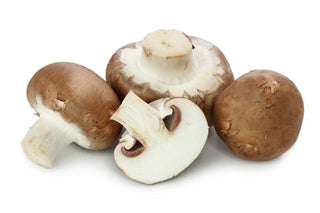Although often thought of as a vegetable and prepared like one, mushrooms are actually a fungus, a special type of living organism that has no roots, leaves, flowers or seeds. A mushroom is the fleshy, spore-bearing fruiting body of a fungus, typically produced above ground on soil or on its food source.
While mushrooms can be cultivated, they can also be found growing wild in many regions of the world. Because there are some 38,000 different types of mushrooms and many of these are poisonous, it is best to obtain your mushrooms from a grocer or a reputable grower.
Fortunately, the most popular edible types (White Button, Portabella, Oyster, Enoki, Shitake, Crimini, Porcini, and Morels) can usually be found easily at your local supermarket.
Although mushrooms have been enjoyed by people around the world for a millennium, it was not until the 17th century that mushroom cultivation began. The first attempts began near Paris, a city that still has hundreds of miles of underground caves and tunnels where mushrooms are grown.
Nutrition & Health Benefits
While the nutritional content varies by type, all mushrooms are low in calories and carbohydrates. Mushrooms are a good source of the b-complex vitamins riboflavin, niacin, pantothenic acid plus the minerals copper, selenium and potassium. For example, one cup of shitake mushrooms provides more than 50% of daily values for pantothenic acid, copper and selenium. And, a cup of portabella mushrooms has 416 mg of potassium or 12% of daily values.
For the past twenty years, the phytonutrients found in mushrooms have been the object of anti-cancer research. Most of this research has centered on carbohydrate-related parts of mushrooms, including their polysaccharide and beta-glucan components. In particular, adding these mushrooms to the diet may help protect against the development of breast cancer by preventing circulating levels of estrogen in the body from becoming excessive. This effect appears to be accomplished through inhibition of an enzyme in the body called aromatase (estrogen synthase) that is necessary for the production of estrogen.
Selection & Storage
Fresh and dried button mushrooms are available year round. When making your selection, look for mushrooms that are firm and plump. Those that are wrinkled or have wet slimy spots should be avoided.
Because mushrooms are porous, they quickly absorb water and become soggy. The best way to clean mushrooms is with a slightly damp paper towel, kitchen cloth, or a mushroom brush, available at most kitchenware stores.
The most effective way to keep your loose button mushrooms fresh is to store them in the refrigerator. Mushrooms should be kept in a loosely closed paper bag (an airtight plastic bag retains moisture and accelerates spoilage), wrapped in a damp cloth or laid out in a glass dish covered with a moist cloth. Mushrooms stored in this way will stay fresh for several days. Prepackaged mushrooms can be stored in their original container for up to a week. Dried mushrooms can be kept fresh for up to a year stored in a tightly sealed container in the refrigerator or freezer.
Recipes and Preparation Tips
Mushrooms are extremely versatile. They may be eaten raw or cooked, whole, sliced, or chopped. Certain varieties (like shiitake and portabella) should have their stems discarded, as they are often tough. Discarding the stem does not influence a mushroom’s nutritional content – the highest concentration of antioxidants is found in the mushroom button.
Dried mushrooms are intensely concentrated in flavor and should be treated more like a seasoning than a vegetable. To re-hydrate dried mushrooms, soak in hot water for 20 – 30 minutes and then rinse. The soaking water can be saved to intensify the mushroom flavor in sauces and soups. Squeezing a small amount of lemon juice on mushrooms helps to retain the cream and tan coloring.
For an easy, healthy recipe, try our Mushroom Lovers Soup which does not use cream and features eight different types of mushrooms.
Fun Facts
Before the invention of synthetic dyes, mushrooms were the source of many textile dyes. Mushroom dyes produce strong and vivid colors, and all colors of the spectrum can be achieved.

